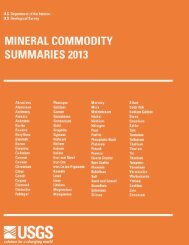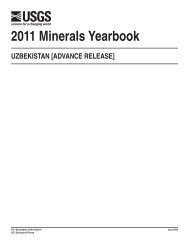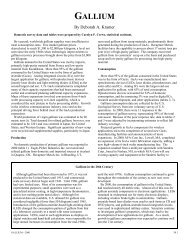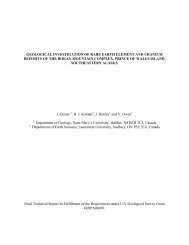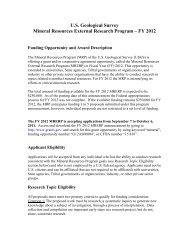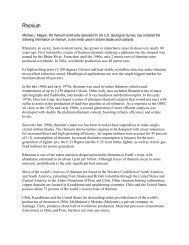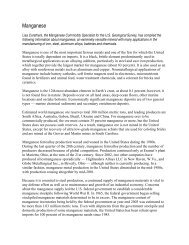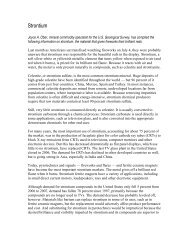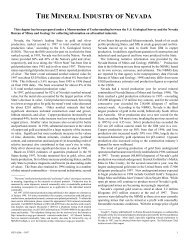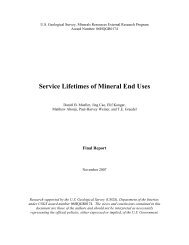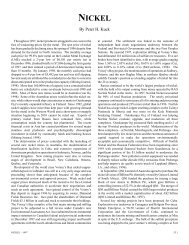Mineral Commodity Summaries 2003 - Mineral Resources Program ...
Mineral Commodity Summaries 2003 - Mineral Resources Program ...
Mineral Commodity Summaries 2003 - Mineral Resources Program ...
You also want an ePaper? Increase the reach of your titles
YUMPU automatically turns print PDFs into web optimized ePapers that Google loves.
SODIUM SULFATE<br />
Events, Trends, and Issues: The first pair of evaporation ponds to produce sodium sulfate with coproduct iodine at<br />
Aguas Blancas, Chile, went into operation at midyear. The initial phase of the project was scheduled to produce<br />
50,000 tons annually with full production targeted for 300,000 tons per year. When in full operation, the facility will be<br />
the largest sodium sulfate producer in South America.<br />
Domestic sodium sulfate demand continued to decline in 2002. Although powdered home laundry detergents may<br />
contain as much as 50% sodium sulfate in their formulation, the market for liquid detergents, which do not contain any<br />
sodium sulfate, continued to grow. Sodium sulfate consumption in the textile industry also has been declining because<br />
imports of less expensive textile products have won a greater share of the domestic market. Declining domestic<br />
demand in the past several years resulted in a decrease of sodium sulfate imports, especially from Canada. However,<br />
growth in powdered home laundry detergents abroad (approximately 80% of world sodium sulfate consumption is for<br />
detergents) and the expanding textile sectors in Central America and South America caused U.S. sodium sulfate<br />
exports to increase. Exports are expected to continue increasing in the next few years.<br />
The outlook for sodium sulfate in <strong>2003</strong> is expected to be comparable with that of 2002, with detergents remaining the<br />
largest sodium sulfate-consuming sector. If the winter of 2002–03 is relatively mild, byproduct recovery of sodium<br />
sulfate from automobile batteries may decline because fewer battery failures during mild winter weather reduces<br />
recycling. World production and consumption of sodium sulfate have been stagnant but are expected to grow in the<br />
next few years, especially in Asia and South America.<br />
World Production, Reserves, and Reserve Base: Although data on mine production for natural sodium sulfate are<br />
not available, total world production of natural sodium sulfate is estimated to be about 4 million tons. Total world<br />
production of byproduct sodium sulfate is estimated to be between 1.5 million and 2.0 million tons.<br />
Reserves 3<br />
Reserve base 3<br />
United States 860,000 1,400,000<br />
Canada 84,000 270,000<br />
Mexico 170,000 230,000<br />
Spain 180,000 270,000<br />
Turkey 100,000 NA<br />
Other countries 1,900,000 2,400,000<br />
World total 3,300,000 4,600,000<br />
World <strong>Resources</strong>: Sodium sulfate resources are sufficient to last hundreds of years at the present rate of world<br />
consumption. In addition to the countries listed above with reserves, the following countries also contain identified<br />
resources of sodium sulfate: Botswana, China, Egypt, Italy, Mongolia, Romania, and South Africa. Commercial<br />
production from domestic resources is from deposits in California and Texas. The brine in Searles Lake, CA, contains<br />
about 450 million tons of sodium sulfate resource, representing about 35% of the lake’s brine. In Utah, about 12% of<br />
the dissolved salts in the Great Salt Lake is sodium sulfate, representing about 400 million tons of resource. An<br />
irregular, 21-meter-thick mirabilite deposit is associated with clay beds 4.5 to 9.1 meters below the lake bottom near<br />
Promontory Point, UT. Several playa lakes in west Texas contain underground sodium-sulfate-bearing brines and<br />
crystalline material. Other economic and subeconomic deposits of sodium sulfate are near Rhodes Marsh, NV,<br />
Grenora, ND, Okanogan County, WA, and Bull Lake, WY. Sodium sulfate can also be obtained as a byproduct from<br />
the production of ascorbic acid, boric acid, cellulose, chromium chemicals, lithium carbonate, rayon, resorcinol, and<br />
silica pigments. The quantity and availability of byproduct sodium sulfate are dependent on the production capabilities<br />
of the primary industries and the sulfate recovery rates.<br />
Substitutes: In pulp and paper, emulsified sulfur and caustic soda (sodium hydroxide) can replace sodium sulfate. In<br />
detergents, a variety of products can substitute for sodium sulfate. In glassmaking, soda ash and calcium sulfate have<br />
been substituted for sodium sulfate with less effective results.<br />
e Estimated. E Net exporter. NA Not available.<br />
1 Source: U.S. Census Bureau. Synthetic production data are revised in accordance with recent updated Census statistics.<br />
2 Defined as imports - exports + adjustments for Government and industry stock changes (if available).<br />
3 See Appendix C for definitions.<br />
157<br />
U.S. Geological Survey, <strong>Mineral</strong> <strong>Commodity</strong> <strong>Summaries</strong>, January <strong>2003</strong>



